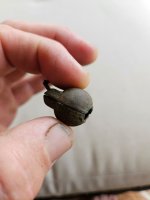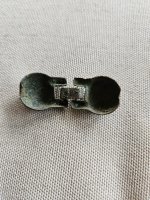Navigation
Install the app
How to install the app on iOS
Follow along with the video below to see how to install our site as a web app on your home screen.
Note: This feature may not be available in some browsers.
More options
You are using an out of date browser. It may not display this or other websites correctly.
You should upgrade or use an alternative browser.
You should upgrade or use an alternative browser.
Musket ball maker?
- Thread starter Sidcane
- Start date
- Feb 3, 2009
- 41,395
- 158,490
- 🥇 Banner finds
- 1
- Detector(s) used
- Deus, Deus 2, Minelab 3030, E-Trac,
- Primary Interest:
- Relic Hunting
How would that work as a mold?I ha e not seen a bullet ball mold like this before.
could it be a small jingle bell mold?
Lead melts at 621F
Brass melts at 1660-1710F
Though the shape is bell like though.
no idea how that would work.How would that work as a mold?
Lead melts at 621F
Brass melts at 1660-1710F
Though the shape is bell like though.
Red-Coat
Gold Member
I don’t know what this is but would be sure it’s not a bullet mould, for a variety of reasons related to impracticality in use.
I racked my brains and could only think of two things I’ve seen which resemble it. One would be a ‘bulla’ amulet but those aren’t seen outside of the ancient Roman period or, very occasionally from the Bronze Age in Ireland (with unrelated heritage). Those would be really unlikely finds in America and fairly rare finds anywhere else, so I’m sure it isn’t one of those.
My second thought… and this is very much a long shot… I wonder if it might be one of these:





They’re called “lime boxes”. Those above are from the 1800s (although they were still in use until at least the 1930s) and vary in size from about an inch in diameter (although I have seen rather smaller ones) up to a couple of inches or so. Some decorated and some plain; some with a catch to close them and some held closed by a spring hinge; some with an interior wall that has a ‘spout’ and some just plain hollow spheres. They’re a fairly common thing in South-East Asian cultures and held “slaked lime” (calcium hydroxide), not lime the fruit.
It was very common for people in those regions to tuck slices of betel ‘nut’ (the fruit of the areca palm) or pieces of the plant’s leaves into their cheeks, either after chewing or pulverising them. Both the nuts and the leaves contain a psychoactive substance similar to nicotine and the addition of the lime raises the pH to help absorption of the substance via the gums. Tobacco was sometimes added to the mix, along with spices for flavouring and the practice spread to the West using tobacco only: ‘chewing’ or ‘spit’ tobacco. You just rolled a twist of baccy with a small amount of lime in the palm of your hand and it helped the oral absorption of the nicotine in the same way.
The lime boxes with the interior wall and spout held dry lime and those without it held it in paste form. They don’t usually have a hole in the end furthest from the hinge like yours appears to have, except for the possibility of there being some kind of catch fastener that was once in that hole (as seen in the first two pictures).
I’m probably way off base, but that’s all I have to offer.
I racked my brains and could only think of two things I’ve seen which resemble it. One would be a ‘bulla’ amulet but those aren’t seen outside of the ancient Roman period or, very occasionally from the Bronze Age in Ireland (with unrelated heritage). Those would be really unlikely finds in America and fairly rare finds anywhere else, so I’m sure it isn’t one of those.
My second thought… and this is very much a long shot… I wonder if it might be one of these:





They’re called “lime boxes”. Those above are from the 1800s (although they were still in use until at least the 1930s) and vary in size from about an inch in diameter (although I have seen rather smaller ones) up to a couple of inches or so. Some decorated and some plain; some with a catch to close them and some held closed by a spring hinge; some with an interior wall that has a ‘spout’ and some just plain hollow spheres. They’re a fairly common thing in South-East Asian cultures and held “slaked lime” (calcium hydroxide), not lime the fruit.
It was very common for people in those regions to tuck slices of betel ‘nut’ (the fruit of the areca palm) or pieces of the plant’s leaves into their cheeks, either after chewing or pulverising them. Both the nuts and the leaves contain a psychoactive substance similar to nicotine and the addition of the lime raises the pH to help absorption of the substance via the gums. Tobacco was sometimes added to the mix, along with spices for flavouring and the practice spread to the West using tobacco only: ‘chewing’ or ‘spit’ tobacco. You just rolled a twist of baccy with a small amount of lime in the palm of your hand and it helped the oral absorption of the nicotine in the same way.
The lime boxes with the interior wall and spout held dry lime and those without it held it in paste form. They don’t usually have a hole in the end furthest from the hinge like yours appears to have, except for the possibility of there being some kind of catch fastener that was once in that hole (as seen in the first two pictures).
I’m probably way off base, but that’s all I have to offer.
Top Member Reactions
-
 3464
3464 -
 2060
2060 -
 1973
1973 -
 1161
1161 -
 1142
1142 -
 926
926 -
 830
830 -
 810
810 -
 807
807 -
 789
789 -
 747
747 -
 530
530 -
 480
480 -
 473
473 -
 445
445 -
 423
423 -
E
416
-
 416
416 -
 414
414 -
 393
393
Users who are viewing this thread
Total: 2 (members: 0, guests: 2)









